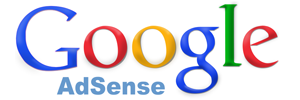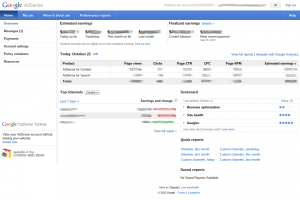Make money with Google AdSense
Introduction to Google AdSense

One of the oldest online advertising networks still in existence, Google AdSense is also possibly the largest. As such, they are very popular with advertisers and publishers alike. In general, publishers will find the performance and eCPMs of AdSense ads tough to beat, and while it is nearly impossible to get one-on-one support from Google, initial setup is usually quite simple.
Overall Rating: 4.50 out of 5.
- What We Like: High payouts (publishers get 68% share); good performance; no minimum traffic requirement; very high fill rate.
- What We Don’t Like: Poor customer service; easy to have your account banned with little chance of a successful appeal.
Google AdSense Company Stats
- Homepage: Google AdSense
- Program Founded In: 2003
- Employee Count: 46,170 as of 2014 Q1 according to Google Investor Relations
- Ownership: Public (GOOG)
- Profiles: Twitter, LinkedIn, Facebook, Google+, Crunchbase, BBB
Google AdSense Support & Contact Information
- Address: 1600 Amphitheatre Pkwy, Mountain View CA 94043
- Phone Number: 650-253-0000
- Support Email: None.
Publisher Requirements
- Publisher Terms: https://www.google.com/adsense/localized-terms
- Traffic Minimum: None.
- Publisher Language Requirement: Content must be primarily in one of these supported languages: Arabic, Bulgarian, Chinese (simplified), Chinese (traditional), Croatian, Czech, Danish, Dutch, English, Estonian, Finnish, French, German, Greek, Hebrew, Hungarian, Indonesian, Italian, Japanese, Korean, Latvian, Lituanian, Polish, Norwegian, Portuguese, Romanian, Russian, Serbian, Slovak, Slovenian, Spanish, Swedish, Thai, Turkish, Ukrainian, Vietnamese.
- Prohibited Publisher Content: Pornography, violence, racial intolerance, excessive profanity, hacking/cracking, illicit drugs, drug paraphernalia, sales of beer or hard alcohol, sales of tobacco or tobacco-related products, sales of prescription drugs, sales of weapons or ammunition, sales of products that are replicas or imitations of designer or other goods, sales or distribution of coursework or student essays, programs which compensate users for clicking ads or offers, performing searches, surfing websites, or reading emails, any other illegal content.
Advertisers & Offers
- Advertising Types: Display, Video.
- Offer Types: CPC.
- Verticals: All.
- Network Size: “2 million publishers worldwide” as of June 19, 2013, according to SocialTimes.
- Sampling of Publishers: NY Times, Digital Photography School, BusinessBalls.com.
Tech Implementation
Google AdSense Tech Implementation Rating: 5 out of 5.
- Creating an Ad Unit: To create a new content display ad unit, click the “My Ads” tab, in the sidebar, click “Content”, then “+New Ad Unit”. You can then name and customize your new ad unit’s size, style, custom channel (for tracking purposes), and more. Finally, simply copy and paste the HTML code into your webpage.
- Display Ad Unit Sizes Available: 728×90, 468×60, 234×60, 125×125, 120×600, 160×600, 180×150, 120×240, 200×200, 250×250, 300×250, 336×280, 300×600, 320×50, 970×90.
- Implementation Technology: HTML, JavaScript.
- Mobile Ad Units Available: Yes.
- WordPress Plugin Available: Yes (third-party only).
Publisher Reporting & Admin Control Panel
Google AdSense Publisher Reporting & Admin Control Panel Rating: 5 out of 5.
- Control Panel: The control panel on AdSense is pretty basic, but extremely functional. You’ll immediately see earnings for the current and previous days, as well as a month-to-date total and any outstanding balances (i.e., what is owed to you currently). There’s also a basic breakdown between Search and Content earnings if applicable, and a summary of relative performance over the past week. AdSense also lets users create customized reports that can be readily available from the control panel as well.
- Reporting: Reporting is one of the highlights and major advantages of Google AdSense. Unlike some networks that report with a lag of 24 hours or more (e.g., Media.net), AdSense delivers results in real time (or pretty darn close to it). The dashboard offers publishers the ability to break down earnings by every metric they could want, including site, ad unit, and day. Beyond the basic functionality that will satisfy 95% of publishers, there are also some advanced features that will help power users analyze results even further.
- Control Panel URL: https://www.google.com/adsense/
Payment
Google AdSense Payment Rating: 5 out of 5.- Publisher’s Share of Revenue: 68%.
- Payment Methods Available: Check, EFT, Western Union, Rapida.
- Payment Terms: Net-30.
- Minimum Payout Threshold: $10.
Account Help
Google AdSense Account Help Rating: 3 out of 5.- Knowledge Base URL: https://support.google.com/adsense/?hl=en
- Personal Account Manager: No.
- Easy to Contact Support: No. There is no support email address. There is a contact form in the help section, but it is difficult to find, and they don’t always respond.
Editor’s Google AdSense Review
Google’s AdSense network is one of the most popular partners for publishers and bloggers seeking to monetize their sites. The AdSense program is relatively simple for most publishers; once approved, they’ll be able to generate code for a variety of ad units that will then appear on their site. AdSense then begins to serve ads, and splits any revenue generated with the publisher.AdSense offers a variety of ad units; beyond the standard sizes (300×250, 728×90, 160×600), there are another dozen ad types available ranging from the large 300×600 to a 120×90 button. In total, publishers have 15 ad sizes to choose from as well as several different options for link units. In addition to the traditional display ads, Google AdSense also offers publishers the ability to show “link units” on their sites. This alternative type of ad unit appears as a line or lines of linked text. Clicking on one of these links takes visitors to a landing page that generally shows multiple ads deemed to be relevant to the visitor. For example, a visitor to a cooking site may see a link unit that contains terms “Cheese fondue recipes” and “Best cookware”. On these units will be several ads from a variety of advertisers; when the visitor clicks on one of these ads, the publisher (and AdSense) generate revenue. Though often overlooked, link units can be a meaningful source of incremental revenue if implemented properly.
Though some ads shown through AdSense are priced on a CPM basis, the vast majority are CPC ads. As such, publishers are compensated not for showing an ad but when a visitor to their site clicks on an ad. AdSense attempts to maximize the number of clicks on each ad. This is done in part by a contextual analysis; AdSense analyzes the words that appear on the page where the ad is served, and attempts to find an ad for a relevant product or service to serve alongside that content.
The sheer size of Google AdSense is one of the biggest draws to publishers; most will have no problem filling 100% of their available inventory immediately. More importantly, AdSense offers a deep pool of advertisers, meaning that the technology can rotate through a wide variety of ad types until it finds a specific category or even specific ad that performs well on your site. With more advertisers available to offer up as potential matches for publishers, AdSense will likely deliver a revenue per thousand pageviews metric that exceeds the vast majority of competitors. AdSense also features a fairly generous payout ratio; publishers get 68% of earnings from Content (the type of AdSense units that account for the bulk of earnings for most publishers) and 51% from Search-related revenue. By comparison, many other networks will offer only a 50/50 split. In addition, publishers get paid relatively quickly; most will have their monthly check within 25 days of the previous month’s end.
Once approved, AdSense gives publishers a significant amount of control over the ads that appear on their sites. This includes the opportunity to customize various aspects of the ads, such as the colors and font sizes. Publishers also have the ability to immediately block any advertisers they don’t want appearing on their site (a major plus if you’re simultaneously trying to build out direct relationships) and even fine tune the types of ads that will appear on the site (for example, increasing or decreasing the frequency of ads from the Hobbies & Leisure Category, or blocking those types of ads completely). Publishers also have the option to show image-only ads on their site; this feature may be appealing to publishers who feel that text ads detract from the perceived quality of their property.
The most frequent complaint about AdSense is the inability to deal directly with any representative from Google; getting in touch with an actual person is next to impossible unless you’re a massive publisher with a dedicated account rep. This can be frustrating if you’re experiencing a technical issue, but shouldn’t be too much of a detriment otherwise.
Given the tremendous popularity of AdSense, there is quite a bit of free information available online regarding optimization strategies and cures for common issues. Another drawback is the restriction placed on the number of ad units; AdSense allows three display ad units (such as a 728×90 or 300×250) as well as three link units and two search boxes. For some sites — especially those with a long vertical layout — three ad units may seem like very little. However, AdSense is fairly flexible in the sense that publishers are allowed to supplement with other networks or direct deals. For example, a publisher may run three AdSense units and three units from Media.net, as long as the non-AdSense ad units are not styled to resemble the look and feel of AdSense units.
References
- https://support.google.com/adsense/?hl=en
- http://adsense.blogspot.com/
- https://forums.digitalpoint.com/forums/adsense.27/
A well written review of your ad network can help to give publishers more
confidence in signing up to your network.
Do you want an ad network review from menetizepros.com?
confidence in signing up to your network.
Do you want an ad network review from menetizepros.com?


Google Adsense is an easy way to make money from your blog. All you need to do is add a script from Google to your website and start displaying ads.
ReplyDeleteYou will get paid for every time a user clicks on the ad. These are called CPC ads.
What is CPC? CPC stands for “cost per click.” By displaying CPC ads with Google Adsense, you receive a set fee every time an ad on your website is clicked by a visitor. The cost per click is set by the advertiser. (This is in contrast to CPM ads, where you’re paid for ad views instead of clicks. CPM means “cost per thousand impressions,” where M is the roman numeral for 1,000.)
Google Adsense is a good way to start earning money online when you are first starting out.
You can see our guide on how to monetize a WordPress blog with Google AdSense to get started, and this tutorial on how to optimize your AdSense revenue for more tips.